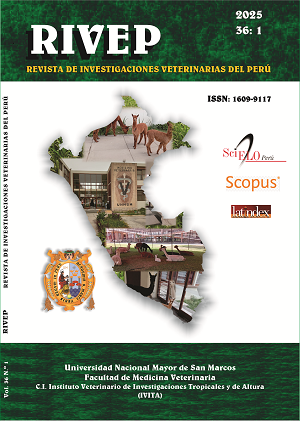Bovine viscera condemnation in a slaughterhouse in Metropolitan Lima and its economic impact
DOI:
https://doi.org/10.15381/rivep.v36i1.30209Keywords:
confiscations, slaughterhouse, cattle, viscera, economic impactAbstract
The aim of this study was to determine the frequency of bovine viscera condemnation in a slaughterhouse in Metropolitan Lima and its economic impact. Monthly slaughter data were collected in 2020, including origin, condemned viscera, and reasons for condemnation. Besides, weights and average market sales prices were also recorded. In 2020, 91 594 bovines were slaughtered, and the frequency of condemnation was 21.78% for liver, 0.93% for lung, and 0.14% for spleen. The main causes were distomatosis (87.28%), abscesses (4.67%), and hydatidosis (3.26%). The economic impact was reflected in an annual loss of US $ 651,303.00 per liver, $ 18,405.00 per lung y US $ 387.00 per spleen.
Downloads
Downloads
Published
Issue
Section
License
Copyright (c) 2025 Angie Stephanie Bernaola Moreno, Francisco Suárez Aranda, Genaro Chaparro Salazar, Faride Vanessa Altamirano Zeballos

This work is licensed under a Creative Commons Attribution 4.0 International License.
AUTHORS RETAIN THEIR RIGHTS:
a. Authors retain their trade mark rights and patent, and also on any process or procedure described in the article.
b. Authors retain their right to share, copy, distribute, perform and publicly communicate their article (eg, to place their article in an institutional repository or publish it in a book), with an acknowledgment of its initial publication in the Revista de Investigaciones Veterinarias del Perú (RIVEP).
c. Authors retain theirs right to make a subsequent publication of their work, to use the article or any part thereof (eg a compilation of his papers, lecture notes, thesis, or a book), always indicating the source of publication (the originator of the work, journal, volume, number and date).



